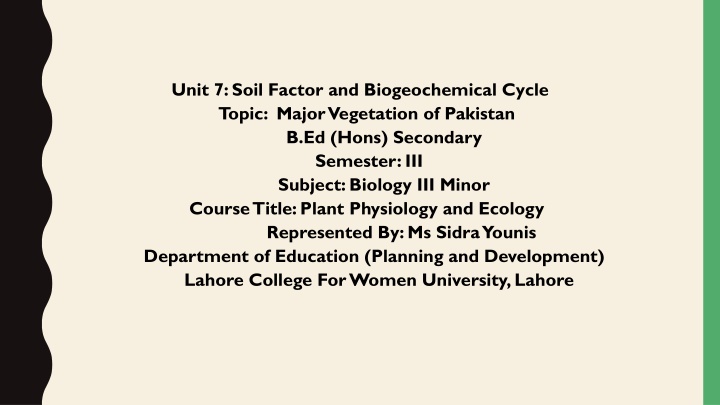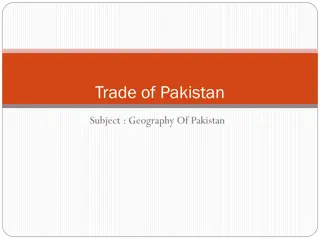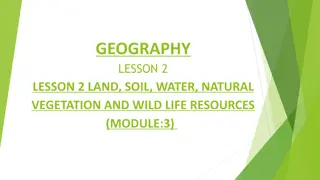Major Vegetation of Pakistan - Overview and Characteristics
Vegetation in Pakistan varies from tropical forests to thorn forests, each with unique adaptations to the climate. Natural and local vegetation types like tropical dry deciduous forests and thorn forests are described, highlighting plant adaptations and environmental factors influencing growth.
Download Presentation

Please find below an Image/Link to download the presentation.
The content on the website is provided AS IS for your information and personal use only. It may not be sold, licensed, or shared on other websites without obtaining consent from the author.If you encounter any issues during the download, it is possible that the publisher has removed the file from their server.
You are allowed to download the files provided on this website for personal or commercial use, subject to the condition that they are used lawfully. All files are the property of their respective owners.
The content on the website is provided AS IS for your information and personal use only. It may not be sold, licensed, or shared on other websites without obtaining consent from the author.
E N D
Presentation Transcript
Unit 7: Soil Factor and Biogeochemical Cycle Topic: Major Vegetation of Pakistan B.Ed (Hons) Secondary Semester: III Subject: Biology III Minor Course Title: Plant Physiology and Ecology Represented By: Ms Sidra Younis Department of Education (Planning and Development) Lahore College For Women University, Lahore
VEGETATION It refers to the ground cover provided by plants. 1. Natural vegetation: Refers to a plant community which has grown naturally without human aid. 2- Local vegetation: Assemblages of plant species and the ground cover they provide
TROPICAL VEGETATION: Tropical vegetation is any vegetation in tropical latitudes. Plant life that occurs in climates that are warm year-round is in general more biologically diverse that in other latitudes. Some tropical areas may receive abundant rain the whole year round, but others have long dry seasons These seasonal droughts have great impact on the vegetation.
DRY TROPICAL FOREST VEGETATION: Climate 1- Temperatures are high 2- Soils: Soils are essentially like those of tropical rain forests, with the same processes. 3- Vegetation: The deciduousness of most tree species. Tree canopy is lower (10-30m). The trees less dense where drought is more extreme. The trees have thicker, more ridged, bark; deeper roots.
4- Plant Adaptations: Trees have thicker bark (antifire adaptation), Thicker and smaller leaves (antidesiccation adaptation), Thorns (antiherbivore adaptation), Longer roots (to reach deeper water table), Dry tropical forest:
TROPICAL DRY DECIDUOUS FORESTS: Forests of low or moderate height consisting almost entirely of deciduous species. Their canopy is typically light though it may appear fairly dense and complete during the short rainy season Not occur extensively in Pakistan but there are limited areas in the Rawalpindi foothills carrying this vegetation type.
TROPICAL THORN FORESTS: A thorny forest is a dense, scrub-like vegetation characteristic of dry subtropical and warm temperate areas with a seasonal rainfall averaging 250 to 500 mm. This vegetation covers a large part of: Southwestern North America and southwestern Africa And smaller areas in Africa, South America, and Australia.
VEGETATION IN THORN FOREST: The major tree species are: Prosopis cineraria (Jhand), Capparis decidua (Karir, Karil), Zizyphus mauritiana (Ber), Tamarix aphylla (Farash) and Salvadora oleoides (Pilu, wan) A characteristic pioneer vegetation is developed on inland sand dunes and the semi-deserts of the areas of least rainfall.
CLIMATE: The climate varies from semi-arid (250 to 750 mm rainfall) to arid (less than 250 mm rainfall). The summer temperature in this tract is as high as 50 C. Prosopis cineraria tree:
MOIST TEMPERATE FORESTS Distinct sub-type of North American coniferous forests. Also called temperate rain forests. Temperature, humidity and encourage the development of mossy, moisture loving plants layer under the giant trees of coast redwood, western red cedar. often moist conditions
HIMALAYAN MOIST TEMPERATE FORESTS: Develop in the areas of lesser rain fall,up to 45 meters tall. Dominant element of vegetation are oak and conifers, under growth is shrubby. Ever green forests of conifers fall in this category, under growth is rarely dense consist of both ever green and deciduous species. These forest occur between 1500m and 3000m elevation in the western himalayas except where the rainfall fall below 1000mm. Divided in 2 zones upper zone and lower zone in which definite species of oak and conifers dominate
HIMALAYAN DRY TEMPERATE FORESTS: Predominantly coniferous forest with xerophytic shrubs. These forest found in dry ranges of Himalayas where precipitation is below 100cm. These forests found at the altitude of 3000m to 4000m in the western Himalayas. Commonly found species belong to indigofera, cannabis, several epiphytic mosses,lichens etc.
SUB-ALPINE VEGETATION: Subalpine zone is the biotic zone below the tree line. Species in this zone depend on the location of the zone on earth. Meadows are present. Conditions favorable for subalpine vegetation are heavy snow,high humidity of soil and air, summer precipitation and good surface drainage. It depends on the geographical location of the mountains. The destruction of forest artificially lowers the boundary of subalpine vegetation and changes its composition.
SUB-TROPICAL VEGETATION: Natural vegetation Subtropical areas are mainly evergreen trees, bushes, and shrubs Hardy evergreen trees like pine and spruce These evergreens are more delicate Plants here are evergreens is because of the long months of warmth and regular rain
WHAT ARE THE TEMPERATURES LIKE Hot humid summers and mild winters Summer the average temperature is between 70 and 80 degrees Coldest month usually averages 45-50 degrees.
DRY SUB-TROPICAL SUB-MOUNTAINOUS VEGETATION Vegetation includes trees and shrubs Trees may show solid growth and shrubs are sharp Average rain fall in this region is 10 36 inches Humidity is low annual mean humidity is 50% Temperature rises to 40 C in summer Area includes Siwalik Hills and Baluchistan Plateau
SUB SUB- -TROPICAL BROAD LEAVED EVERGREEN FOREST TROPICAL BROAD LEAVED EVERGREEN FOREST Broad-leaved evergreen forest Broad-leaved forests occur in the formation types (a)Broad-leaved evergreen (b)Broad-leaved deciduous This forest type requires plentiful, well-distributed rainfall
SUB-TROPICAL PINE FOREST Tropical pine forests are confined to Nepal, Bhutan, states of Jammu and Kashmir Pine forests are mainly classified into types Lower Siwalik Chir Pine Forest and Upper (Himalayan) Chir pine forest The variety of life forms i.e. Flora and fauna
TEMPERATURE-VEGETATION Temperature is one of the three major influences on global patterns of plant growth With available sunlight and water Temperature determines wheather Where vegetation is dense, the land surface temperature never rises above 35 degrees Celsius
DRY TEMPERATE FORESTS Unfavorable climate Have less number of plants This area has bare soil Plants are mostly Xerophytic Region includes Suleiman Range,Karakoram Range This region has long cold winter, Temperature becomes lower than zero Some of these areas are covered by snow























